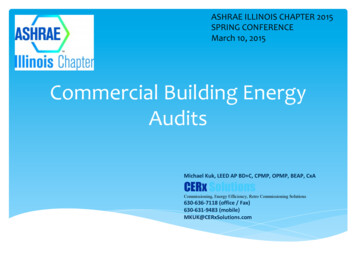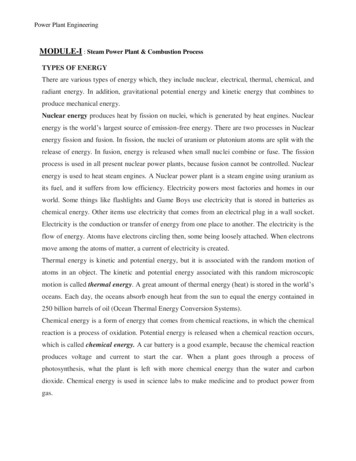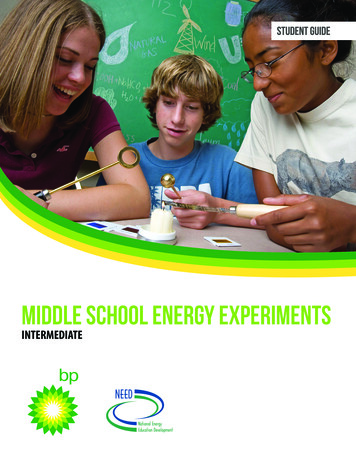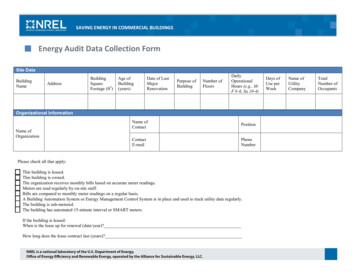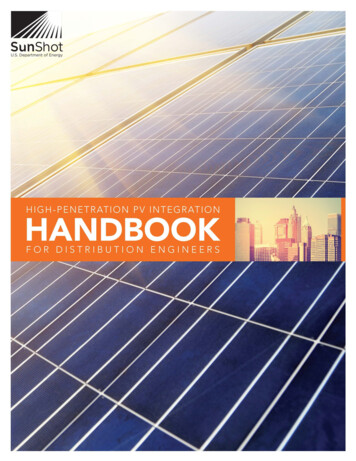
Transcription
U.S. Department of Energy
High-Penetration PV IntegrationHandbook for DistributionEngineersRich Seguin, Jeremy Woyak, David Costyk,and Josh HambrickElectrical Distribution DesignBarry MatherNational Renewable Energy LaboratoryNREL is a national laboratory of the U.S. Department of EnergyOffice of Energy Efficiency & Renewable EnergyOperated by the Alliance for Sustainable Energy, LLCThis report is available at no cost from the National Renewable EnergyLaboratory (NREL) at www.nrel.gov/publications.Technical ReportNREL/TP-5D00-63114January 2016Contract No. DE-AC36-08GO28308
High-Penetration PVIntegration Handbook forDistribution EngineersRich Seguin, Jeremy Woyak, David Costyk,and Josh HambrickElectrical Distribution DesignBarry MatherNational Renewable Energy LaboratoryPrepared under Task No. SS12.2930NREL is a national laboratory of the U.S. Department of EnergyOffice of Energy Efficiency & Renewable EnergyOperated by the Alliance for Sustainable Energy, LLCThis report is available at no cost from the National Renewable EnergyLaboratory (NREL) at www.nrel.gov/publications.National Renewable Energy Laboratory15013 Denver West ParkwayGolden, CO 80401303-275-3000 www.nrel.govTechnical ReportNREL/TP-5D00-63114January 2016Contract No. DE-AC36-08GO28308
NOTICEThis report was prepared as an account of work sponsored by an agency of the United States government.Neither the United States government nor any agency thereof, nor any of their employees, makes any warranty,express or implied, or assumes any legal liability or responsibility for the accuracy, completeness, or usefulness ofany information, apparatus, product, or process disclosed, or represents that its use would not infringe privatelyowned rights. Reference herein to any specific commercial product, process, or service by trade name,trademark, manufacturer, or otherwise does not necessarily constitute or imply its endorsement, recommendation,or favoring by the United States government or any agency thereof. The views and opinions of authorsexpressed herein do not necessarily state or reflect those of the United States government or any agency thereof.This report is available at no cost from the National Renewable EnergyLaboratory (NREL) at www.nrel.gov/publications.Available electronically at SciTech Connect http:/www.osti.gov/scitechAvailable for a processing fee to U.S. Department of Energyand its contractors, in paper, from:U.S. Department of EnergyOffice of Scientific and Technical InformationP.O. Box 62Oak Ridge, TN 37831-0062OSTI http://www.osti.govPhone: 865.576.8401Fax: 865.576.5728Email: reports@osti.govAvailable for sale to the public, in paper, from:U.S. Department of CommerceNational Technical Information Service5301 Shawnee RoadAlexandria, VA 22312NTIS http://www.ntis.govPhone: 800.553.6847 or 703.605.6000Fax: 703.605.6900Email: orders@ntis.govCover Photos by Dennis Schroeder: (left to right) NREL 26173, NREL 18302, NREL 19758, NREL 29642, NREL 19795.NREL prints on paper that contains recycled content.
AcknowledgmentsThis work was supported by the U.S. Department of Energy under Contract No. DOEEE0002061 with the National Renewable Energy Laboratory. The authors thank Dr. RangaPitchumani, Alvin Razon and Kevin Lynn for their present or past support of the NREL/SCEHigh-Penetration PV Integration Project. The authors would also like to thank the CaliforniaSolar Initiative (CSI) RD&D Program and Program Manager Itron, namely Anne Peterson andStephan Barsun, for past support of the NREL/SCE Hi-Penetration PV Integration Project thatprovided for a broader analysis of high-penetration PV circuits than otherwise would have beenpossible. Thanks are due to Southern California Edison (SCE) for their long-term support of theproject and for providing circuit models, operational data, and access to real-world sets ofdistribution systems on which the findings of the project are summarized in this handbook.The information included in this handbook, and the general scope of the handbook, was steeredand edited by a select number of distribution engineering experts formally organized into theDistribution Energineering Review Committee (DERC). The DERC members were:Dr. Thomas McDermott P.E. – University of PittsburghSteve Steffel P.E. – Pepco Holdings Inc.Phuong Tran – Lakeland ElectricHawk Asgerisson P.E. – DTE EnergySylvester Toe P.E. – Georgia PowerFranco Bruno – Central Hudson Gas and ElectricAraya Gebeyehu P.E. – Southern California EdisonIn addition to those listed above, the staff members working on PV interconnection at some ofthe above utilities also reviewed drafts of the handbook. All the comments and edits from theexperts in the DERC and their staff members were instrumental in keeping the informationcontained in and the scope of this handbook relevant to practicing distribution engineers. Thanksto the DERC and other reviewers for their time and effort reviewing drafts of the handbook.Finally, thanks are due to the other team members and collaborator in the NREL/SCE HighPenetration PV Integration Project. While this Handbook can’t possibly show the whole extent ofthe research completed under the auspices of the project all such work was critical in producing abetter understanding of the impacts of high-penetration PV integration on the distribution systemand how to determine and mitigate those impacts. Thanks to Quanta Technology, Clean PowerResearch, Satcon Technology Corp. and the Florida State University Center for Advanced PowerSystems.iiiThis report is available at no cost from the National Renewable Energy Laboratory (NREL) at www.nrel.gov/publications
List of rnating currentdirect currentdistributed generationdirect transfer tripInstitute of Electrical and Electronics EngineersInformation Technology Industry Councilload tap changerpower factorpoint of interconnectionphotovoltaicsupervisory control and data acquisitiontemporary overvoltagevoltage regulating transformerivThis report is available at no cost from the National Renewable Energy Laboratory (NREL) at www.nrel.gov/publications
Table of Contents12Introduction . 11.11.21.3Background on the NREL/SCE Hi-Pen Project . 1Intended Use of this Handbook . 3Organization of the Handbook . 32.12.2Introduction . 4Overload-Related Impacts . 42.2.1 Ampacity Ratings . 42.2.2 Masked Load . 52.2.3 Cold Load Pickup . 5Voltage-Related Impacts . 62.3.1 Feeder Voltage Profile . 62.3.2 Overvoltage . 62.3.3 Potential for Increased Substation Voltage . 72.3.4 Flicker . 72.3.5 Automatic Voltage Regulation Equipment . 8Reverse Power Flow Impacts . 102.4.1 Substation and Bulk System Impacts . 102.4.2 Temporary and Transient Overvoltage. 102.4.3 Automatic Voltage Regulation Equipment . 12System Protection Impacts . 132.5.1 Fault Current and Interrupting Rating . 132.5.2 Fault Sensing . 142.5.3 Desensitizing the Substation Relay . 152.5.4 Line-to-Ground Utility System Overvoltage . 162.5.5 Nuisance Fuse Blowing . 172.5.6 Reclosing Out of Synchronism . 182.5.7 Islanding . 182.5.8 Sectionalizer Miscount . 192.5.9 Reverse Power Relay Operation—Malfunctions on Secondary Networks . 192.5.10 Reverse Power Relay Operation—Substation . 202.5.11 Cold Load Pickup With and Without PV . 202.5.12 Faults Within a PV Zone . 222.5.13 Isolating PV for an Upstream Fault. 232.5.14 Fault Causing Voltage Sag and Tripping PV . 232.5.15 Distribution Automation Studies and Reconfiguration . 23Circuit Configurations . 242.6.1 Normal System Configuration . 242.6.2 Abnormal System Configuration . 242.6.3 Future/Planned System Configurations . 242.6.4 Contingency Conditions . 25High-Penetration PV Distribution-Level Impacts . 42.32.42.52.63Model-Based Study Guide for Assessing PV Impacts. 273.13.23.3Introduction . 27Develop a Base Case Model. 293.2.1 Distribution Circuit Models . 303.2.2 PV System Models . 37Time Series Input—Develop Data Used to Inform the Models . 403.3.1 Utility SCADA Data (Synchronizing Data and Navigating the Issues) . 403.3.2 Modeled PV Power Output Data (with existing PV Plant Data). 41vThis report is available at no cost from the National Renewable Energy Laboratory (NREL) at www.nrel.gov/publications
3.43.53.63.743.3.3 Clear-Sky Calculated PV Power Output Data . 42Validate Time Series Measurement Data . 433.4.1 Validate Circuit Model . 433.4.2 Add Measurements . 433.4.3 Run Power Flow . 43Determine Quasi-Steady-State Critical Time Points and Study Criteria . 433.5.1 Identify Critical Time Points . 443.5.2 Choose Study Criteria . 44Analyze and Assess PV Impact . 443.6.1 Assess PV Using Power Flow Analysis . 473.6.2 Assess PV Using Fault Analysis . 48Porterville Example—PV Assessment . 493.7.1 Developing the System Model . 513.7.2 Assessing PV Using Power Flow Analysis—Example 1 . 523.7.3 Assessing PV Using Fault Analysis—Example 1 . 603.7.4 Assessing PV Using Power Flow Analysis—Example 2 . 623.7.5 Assessing PV Using Fault Analysis—Example 2 . 67Mitigation Techniques for High-Penetration PV Impacts . 714.14.24.34.44.54.6Introduction . 71Mitigation Techniques Supported by PV Inverter Capabilities . 714.2.1 Constant Power Factor Operation . 714.2.2 Other Advanced PV Controls . 72Mitigation Techniques to Alleviate PV Impacts . 744.3.1 Steady-State Voltage Impacts . 744.3.2 Dynamic Voltage Impacts . 754.3.3 Reverse Power Flow Impacts . 764.3.4 Overload Impacts . 774.3.5 System Protection Impacts . 77Porterville Example—Constant Power Factor Operation . 80Additional Advanced Inverter Techniques. 824.5.1 Power Factor Scheduling . 824.5.2 Reactive Power Compensation or Constant VAR Operation . 824.5.3 Active Volt/VAR Control or Dynamic Voltage Control. 83Selecting a Mitigation Technique. 86References . 88Appendix A: Review and Fix Bad Data . 90Discover Bad Data. 90Tabular Format . 90SQL Queries Within Access. 92Ignore Bad Data. 93Correct Bad Data . 94Correct Data Using SQL Queries Within Access. 95Correct Data Using Excel . 95Appendix B: Criteria for Evaluating PV Generation Impacts. 96viThis report is available at no cost from the National Renewable Energy Laboratory (NREL) at www.nrel.gov/publications
List of FiguresFigure 2.1. Masked load—difference between measured load and native load on a peak load day (Matheret al. 2014). 5Figure 2.2. Impact of solar PV on the voltage profile of a feeder. 7Figure 2.3. Impact of solar PV on voltage compensation provided by line drop compensation. . 9Figure 2.4. Peak load voltage profiles—PV compared to no PV. 9Figure 2.5. Example of TOV due to load rejection (Nelson et al. 2015) . 11Figure 2.6. Example of transient overvoltage . 11Figure 2.7. Runaway voltage regulator . 13Figure 2.8. Impact of PV on fuse interruption ratings . 14Figure 2.9. Impact of PV on breaker interruption ratings . 14Figure 2.10. PV may desensitize protection devices to faults. 15Figure 2.11. Reduction in fault current through substation relay because of PV . 16Figure 2.12. PV may cause line-to-ground overvoltage . 17Figure 2.13. Illustration of nuisance fuse-blowing caused by large PV penetration . 18Figure 2.14. Reclosing out of synchronism . 18Figure 2.15. Illustration of sectionalizer miscount because of PV. 19Figure 2.16. Reverse power relay operation because of PV . 20Figure 2.17. Time-varying characteristic of cold load (Lawhead at el. 2006) . 22Figure 2.18. PV may be isolated for an upstream fault . 23Figure 2.19. Reconfiguration in the presence of PV . 24Figure 2.20. (a) Normal and (b) abnormal configuration of an auto loop system, red indicates a closedswitch, green indicates an open switch . 25Figure 2.21. Overload during normal and contingency conditions . 26Figure 3.1. Flowchart for model development . 28Figure 3.2. Flowchart for performing PV impact studies . 29Figure 3.3. (Left) Detailed and (right) simplified models of distribution substations . 31Figure 3.4. Example of voltage regulators and control details . 32Figure 3.5. Example of voltage regulator compensation . 33Figure 3.6. Representative capacitor bank control and timing parameters . 34Figure 3.7. Calculating the native load . 36Figure 3.8. PV impact study flowchart . 46Figure 3.9. DEW’s DER automated assessment application dialog . 50Figure 3.10. Map of the Porterville circuit. 51Figure 3.11. Porterville overhead capacitor control used for voltage regulation . 52Figure 3.12. Scenario 1—worst-case study criteria violations for critical load days. 53Figure 3.13. Porterville example study results—flicker associated with sudden loss and return of rated PVat POI . 55Figure 3.14. Porterville example study results—capacitor switching compared to percentage loss ofPV . 56Figure 3.15. Porterville example study results—flicker associated with sudden loss and return of rated PVat the POI compared to the fixed absorbing power factor. 57Figure 3.16. Porterville example study results—capacitor switching compared to loss of rated PV withfixed absorbing power factor . 58Figure 3.17. Porterville example study results—5-MW PV site radiant variability analysis by minute . 59Figure 3.18. Porterville example study results—5-MW PV site radiant variability analysis by hour . 59Figure 3.19. Porterville example study results—detailed fault assessment of the circuit . 61Figure 3.20. Porterville example study results—circuit breaker desensitizing with PV. 62Figure 3.21. Single-line diagram of the circuit section used for the transient overvoltage study . 63Figure 3.22. Voltage across line charging capacitance . 67viiThis report is available at no cost from the National Renewable Energy Laboratory (NREL) at www.nrel.gov/publications
Figure 4.1. Porterville example study results—flicker associated with sudden loss and return of rated PVat the POI compared to the fixed absorbing power factor. 82Figure 4.2. Example of reactive droop curve with dead band . 83Figure 4.3. Schematic of the 8,500-node test feeder reduced to include only the primary circuit (Matheret al. 2014). 84Figure 4.4. Comparison of voltages at PV POIs when PV systems are operating with different controlstrategies (Mather et al. 2014). 85Figure 4.5. Comparison of voltages at Load 3 and Load 6 when PV systems use different controlstrategies (Mather et al. 2014). 86Figure 4.6. Reactive power of the PV systems for various control strategies (Mather et al. 2014) . 86List of TablesTable 3.1. PV Generation Data Resources . 42Table 3.2. Sample DER Impact Study Criteria . 44Table 3.3. Porterville Example Study Results—Variability for 2011. 60Table 3.4. Porterville Example Study Results—Worst-Case Fault Analysis . 60Table 3.5. Parameters for the Circuit Section Shown in Figure 3.21. 65Table 3.6. Initial Conditions and Pre-Islanding Inverter Currents . 66Table 3.7. Substation Impedance . 68Table 3.8. Relay Settings . 68Table 3.9. Fault Currents at the Substation . 68Table 3.10. Fault Currents at the Location of West PV Provided by the Substation . 69Table 3.11. Fault Currents at the Location of East PV Provided by the Substation . 69Table 3.12. Fault Current at the Switch . 69Table 4.1. Voltage at the Point of Common Coupling and Corresponding Clearing Time . 76viiiThis report is available at no cost from the National Renewable Energy Laboratory (NREL) at www.nrel.gov/publications
1 Introduction1.1 Background on the NREL/SCE Hi-Pen ProjectThis handbook has been developed as part of a five-year research project which began in 2010.The National Renewable Energy Laboratory (NREL), Southern California Edison (SCE), QuantaTechnology, Satcon Technology Corporation, Electrical Distribution Design (EDD), and CleanPower Research (CPR) teamed together to analyze the impacts of high-penetration levels ofphotovoltaic (PV) systems interconnected onto the SCE distribution system. This project wasdesigned specifically to leverage the experience that SCE and the project team would gain duringthe significant installation of 500 MW of commercial scale PV systems (1-5 MW typically)starting in 2010 and completing in 2015 within SCE’s service territory through a programapproved by the California Public Utility Commission (CPUC). The research objectives of thisproject included the following:Development of distribution and PV system models required to evaluate the impacts of highpenetration PVIdentification and development of the necessary distribution system studies and analysisappropriate for determining the impacts of high-penetration PVDevelopment of high-penetration PV impact mitigation strategies in the form of advancedinverter functions to enable high-penetration PV interconnectionLab testing of advanced PV inverter functionsField testing of advanced PV inverter functionsDevelopment of a handbook for high-penetration PV grid integration that is useful todistribution system engineers facing the integration of high-penetrations of PV into theirservice territories.Many of the above objectives and their resulting research outcomes have informed thedevelopment of this handbook which directly correlates to the last research objective listedabove. This handbook is not inclusive of all the research outcomes of the project. For furtherreading on the project and its research results please see the following select publications:B. Mather, B. Kroposki, R. Neal, F. Katiraei, A. Yazdani, J. R. Aguero, T. E. Hoff, B. L.Norris, A. Parkins, R. Seguin, C. Schauder, Southern California Edison High-PenetrationPhotovoltaic Project – Year 1, NREL Technical Report, TP-5500-50875, June, 2011.B. Mather, R. Neal, Integrating High Penetrations of PV into Southern California: Year 2Project Update, proc. of IEEE Photovoltaic Specialists Conference, Austin, TX, June,2012.B. Mather, M. Kromer, L. Casey, Advanced Photovoltaic Inve
Handbook for Distribution Engineers Rich Seguin, Jeremy Woyak, David Costyk, and Josh Hambrick Electrical Distribution Design Barry Mather National Renewable Energy Laboratory Technical Report NREL/TP-5D00-63114 . January 2016 . NREL is a national laboratory of the U.S. Department of Energy






